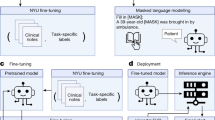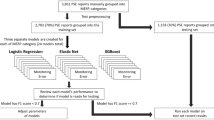Abstract
Medication errors most commonly occur at the ordering or prescribing stage, potentially leading to medical complications and poor health outcomes. While it is possible to catch these errors using different techniques; the focus of this work is on textual and contextual analysis of prescription information to detect and prevent potential medication errors. In this paper, we demonstrate how to use BERT-based contextual language models to detect anomalies in written or spoken text based on a data set extracted from real-world medical data of thousands of patient records. The proposed models are able to learn patterns of text dependency and predict erroneous output based on contextual information such as patient data. The experimental results yield accuracy up to 96.63% for text input and up to 79.55% for speech input, which is satisfactory for most real-world applications.
Access this chapter
Tax calculation will be finalised at checkout
Purchases are for personal use only
Similar content being viewed by others
References
Devlin, J., Chang, M. W., Lee, K., & Toutanova, K. (2019). Bert: Pre-training of deep bidirectional transformers for language understanding. In NAACL
Latif, S., Qadir, J., Qayyum, A., Usama, M., & Younis, S. (2021). Speech technology for healthcare: Opportunities, challenges, and state of the art. IEEE Reviews in Biomedical Engineering, 14, 342–356.
Lee, J., Yoon, W., Kim, S., Kim, D., Kim, S., So, C. H., & Kang, J. (2020). Biobert: A pre-trained biomedical language representation model for biomedical text mining. Bioinformatics, 36(4), 1234–1240.
McCann, B., Bradbury, J., Xiong, C., & Socher, R. (2017). Learned in translation: Contextualized word vectors. In Proceedings of the 31st International Conference on Neural Information Processing Systems, NIPS’17 (pp. 6297–6308).
Mikolov, T., Sutskever, I., Chen, K., Corrado, G. S., & Dean, J. (2013). Distributed representations of words and phrases and their compositionality. In Advances in Neural Information Processing Systems (Vol 26)
Mulac, A., Taxis, K., Hagesaether, E., & Gerd Granas, A. (2021). Severe and fatal medication errors in hospitals: Findings from the norwegian incident reporting system, 28(Suppl 2), s56–s61. https://doi.org/10.1136/ejhpharm-2020-002298.
Oura, P. (2021). Medical adverse events in the us 2018 mortality data. Preventive Medicine Reports, 24, 101574.
Peters, M. E., Neumann, M., Iyyer, M., Gardner, M., Clark, C., Lee, K., & Zettlemoyer, L. (2018). Deep contextualized word representations. In Proceedings of the 2018 Conference of the North American Chapter of the Association for Computational Linguistics: Human Language Technologies (Vol. 1 (Long Papers), pp. 2227–2237), New Orleans, Louisiana. https://doi.org/10.18653/v1/N18-1202.
Povey, D., Ghoshal, A., Boulianne, G., Burget, L., Glembek, O., Goel, N., Hannemann, M., Motlicek, P., Qian, Y., Schwarz, P., Silovsky, J., Stemmer, G., & Vesely, K. (2011). The kaldi speech recognition toolkit.
Rodziewicz, T. L., Houseman, B., & Hipskind, J. E. (2020). Medical error prevention. Treasure Island (FL): StatPearls Publishing.
Tariq, R. A., Vashisht, R., Sinha, A., & Scherbak, Y. (2021). Medication dispensing errors and prevention. Treasure Island (FL): StatPearls Publishing.
Vaswani, A., Shazeer, N., Parmar, N., Uszkoreit, J., Jones, L., Gomez, A. N., Kaiser, L., & Polosukhin, I. (2017). Attention is all you need. In Advances in Neural Information Processing Systems (Vol. 30).
Wu, Y., Schuster, M., Chen, Z., et al. (2016). Google’s neural machine translation system: Bridging the gap between human and machine translation. arXiv:1609.08144.
Acknowledgements
We acknowledge Dr. Yuan Gong for giving suggestions for this project.
Author information
Authors and Affiliations
Corresponding author
Editor information
Editors and Affiliations
Rights and permissions
Copyright information
© 2023 The Author(s), under exclusive license to Springer Nature Switzerland AG
About this chapter
Cite this chapter
Jiang, Y., Poellabauer, C. (2023). Medication Error Detection Using Contextual Language Models. In: Shaban-Nejad, A., Michalowski, M., Bianco, S. (eds) Multimodal AI in Healthcare. Studies in Computational Intelligence, vol 1060. Springer, Cham. https://doi.org/10.1007/978-3-031-14771-5_7
Download citation
DOI: https://doi.org/10.1007/978-3-031-14771-5_7
Published:
Publisher Name: Springer, Cham
Print ISBN: 978-3-031-14770-8
Online ISBN: 978-3-031-14771-5
eBook Packages: Intelligent Technologies and RoboticsIntelligent Technologies and Robotics (R0)




